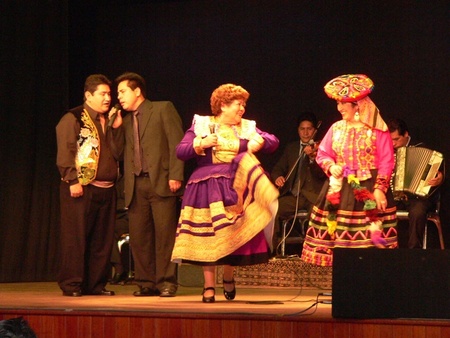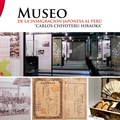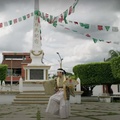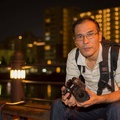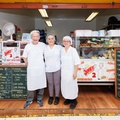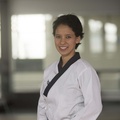Part 1 >>
How did it arrive in the Japanese colony?
(Luis) Toyama took me, he was president of the Nikkei University Center. He took me to the colony to teach. He brought folklore workshops into the colony, as well as all Peruvian music. By then the activity was in Peru Shimpo, in Jirón Puno.
The auditorium that was on the third floor.
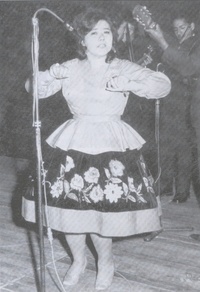
Closed Coliseum of the Army Bridge, Lima, 1962. (Photo: Taken from the book My life. The world I knew, by Angélica Harada Vásquez, Little Princess of Yungay)
Yes. I performed there like two or three times. Then he said “we have to form a Peruvian dance group.” They called me, they told me “you teach Peruvian dances.” I said to myself “now what a dance, I don't know anything except singing”. But I remembered a lady, Julia Peralta, she taught dance. So I told him to teach me. “Ah now,” he told me. Step that I learned, step that I taught in the colony. There was a festival in the neighborhood, with performances from all departments. They told me that with the Andean to represent Fukuoka. There they danced, and the Andean won. How they applauded the Peruvian dances, the dances that I had taught.
You were received in Miyano (Fukuoka), your father's town, like a celebrity.
Yes (laughs). That was the Cinderella story. It's like a provincial who comes to Lima and doesn't know the streets, he's lost. So did I, back in Japan, wherever they took me I went. The people in charge were those who had invited me, the Inti group and Mrs. Haydé from Fukusaku. They welcomed us well. We arrived first in Fukuoka and then they took me to my dad's land. They gave us a car where journalists, cameramen, and reporters got on. I said “it must be because I dress from Peru.” I dressed a lot like Cusco because it was more striking. There they order that I am going to be the last one to get off.
They went to school, right?
To a school that my grandfather founded. There is his monument. There I see any number of people. He said “they must not have been wrong (laughs), they are being confused with another artist.” I was afraid, my legs couldn't stand up, they were bending from nerves. There the director receives me and takes me to the office. I looked for Mrs. Haydé to ask her what was happening, I said “Mrs. Haydé, couldn't they have made a mistake?” “No,” he tells me, “it's you they're receiving.” She explained to me that this school had been founded by my grandfather. Well, a very nice ceremony. There the director tells me “we have a surprise for you: that man who is sitting there is your first cousin.” What could it be, the nerves, they don't hug there, I hugged him like a bear, I got passionate (laughs). And then the entertainment, the toast. They had prepared the students to sing to the Little Princess of Yungay. A child came out to welcome me: “you have come from so far away to see the land of your ancestors.” I also hugged the boy and gave him a kiss, and he got scared (laughs).
The Japanese are not used to it.
Nooo.
His cousin was also surprised.
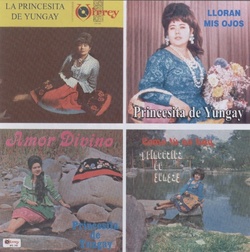
LP's from the vast production of the Little Princess of Yungay. (Photo: Taken from the book My life. The world I knew, by Angélica Harada Vásquez, Little Princess of Yungay)
Yes, and then it disappeared. “Where is your cousin?” Mrs. Haydé told me. “He must have been scared because I hugged him.” From there the mayor called me, gave me the key to the city, and told me “you are the daughter of this town, you can stay here, you can come as many times as you want, this is the town of your parents.” Very nice. There all the workers told me to sing. I started singing a cappella, they didn't understand me but they applauded me anyway (laughs). Then they take us to my grandparents' house, a very beautiful house, it was a big banquet. And there was my cousin. For me it was a dream. I had never imagined that reception in my dad's country. It is a very great memory for me.
It must have been especially exciting to see the place where their story began.
Like all children in the world, who doesn't want to know the place where their parents were born. That's what I expected and it came to me. The Japanese colony helped me a lot. Then Mr. Augusto Ikemiyashiro was president. They gave me the ticket.
In what year?
In the 90's.
When Peruvians emigrated en masse to Japan.
I found many Peruvians there. There was a lot of melancholy, a lot of sadness, nostalgia. And it occurred to me to sing the waltz “Las locas ilusiones” (laughs).
When the history of Japanese immigration to Peru is discussed and prominent Nikkei are mentioned, their name always appears. What does it mean to you to be considered among the best that a community has given to the country?
I receive it with all humility. First of all, thanking God for being an interpreter of my country, this country, Peru, which gave hospitality to my father. I hope to continue succeeding, or not so much anymore, because I don't ask for much anymore. I have only been waiting with great anxiety for my Golden Wedding Anniversary to arrive this year. After a little while I will retire from art. But I leave behind seven artists that I have created, who are already walking.
They are his successors.
Yes. Now seeing them sing, applauding them, is a satisfaction for me. If I were a millionaire, what wouldn't I do for Peruvian culture. There is a lot of human material that needs opportunities, there are talents. What a pity that one wants and cannot do anything.
* This article is published thanks to the agreement between the Peruvian Japanese Association (APJ) and the Discover Nikkei Project. Article originally published in Kaikan magazine No. 50, October 2010 and edited for Discover Nikkei.
© 2010 Asociación Peruano Japonesa / © 2010 Fotos: Asociación Peruano Japonesa.



